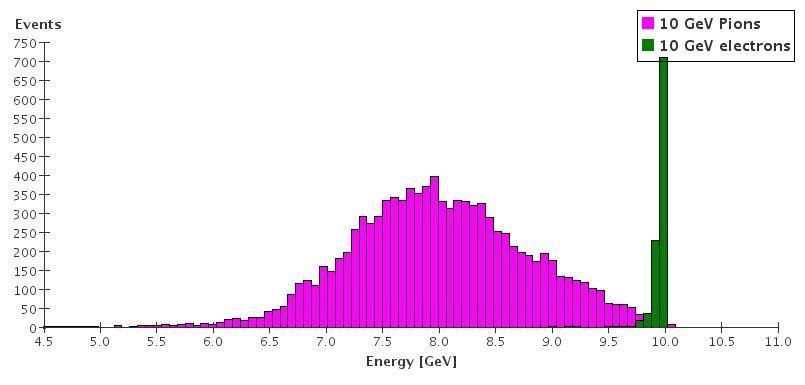Note: Work in Progress !!
Introduction
In this exercise we will use LCDD, an extension of the standard Geant4 GDML format, to describe a complete detector setup, including sensitive detectors and readout. Since we are using XML to configure Geant4 there is no need to write any C++ code we can use a version of SLIC which has been pre-built with support for GDML included. In this example we will use a simple test beam like calorimeter consisting of lead glass blocks of 1 cubic cm. For each calorimeter cell we read out the Ionization loss as well as the energy deposited by cherenkov photons. Example LCDD files, macros to run SLIC and java programs to analyze the LCIO output files from within JAS3 are provided and are attached to this document.
Principle of a dual read out calorimeter
For e+, e- and photons the total energy of the incoming particle is converted into detectable kinetic energy of electrons leading to excellent energy resolution for electrons/photons. Hadrons on the other hand break nuclei and liberate nucleons/nuclear fragments. Even if the kinetic energy of the resulting nucleons is measured, the significant fraction of energy is lost to overcome the binding energy. Fluctuations of the number of broken nuclei dominate fluctuations of the observed energy leading to a relatively poor energy resolution for hadrons. This is demonstrated in the figure below where the ionization loss of a 10 GeV Pion is compared with the ionization loss of a 10 GeV electron. In both cases we use a simple Iron block as an absorber that contains the entire shower.
Large number of broken nuclei:
- Large number of slow neutrons
- Small fraction of energy in a form of neutral pions.
Very few broken nuclei:
- Small number of slow neutrons
- Large fraction of energy in a form of neutral pions.
Eem/Etot ~ ECherenkov/Eionization
'EM' shower => Relativistic electrons => Lots of Cherenkov light
Hadronic shower => Most particles below the Cherenkov threshold
Use this fact to correct hadron response
Correlation between the total observed ionization energy and the electromagnetic component of the shower, as measured by the Cherenkov component. The calibration factor K is determined by the requirement that K×ECherenkov = Eionization for electrons.
The CCAL02 detector
Is an implementation of a daul read-out, total absorption crystal calorimeter made of BGO crystals. CCAL02 is based on the SID02 geometry but the space currently occupied by ECAL/HCAL Barrel/Endcap is replaced by the Crystal calorimeter. All other detectors (tracking etc.) as they are. ECAL deep enough to contain most EM showers.
Material |
Density |
Radiation length |
Interaction length |
||
|---|---|---|---|---|---|
<ac:structured-macro ac:name="unmigrated-wiki-markup" ac:schema-version="1" ac:macro-id="50230333-6fcb-4154-bb42-4477d932cf59"><ac:plain-text-body><![CDATA[ |
|
[g/cm3] |
[cm] |
[cm] |
]]></ac:plain-text-body></ac:structured-macro> |
BGO |
7.13 |
1.12 |
21.88 |
||
PbWO4 |
8.3 |
0.9 |
18. |
||
SCG1-C |
3.36 |
4.25 |
45.6 |
|
|
|
|
BGO |
|
PbWO4 |
|
||
|---|---|---|---|---|---|---|---|---|---|
Detector |
Layers |
Thickness/layer |
Segmentation |
X0 |
Lambda |
X0 |
Lambda |
||
<ac:structured-macro ac:name="unmigrated-wiki-markup" ac:schema-version="1" ac:macro-id="3fdb795f-a875-4865-940a-a6d79947e24f"><ac:plain-text-body><![CDATA[ |
|
|
[cm] |
[cmxcm] |
|
|
|
|
]]></ac:plain-text-body></ac:structured-macro> |
ECAL Barrel |
8 |
3 |
3x3 |
21.4 |
1.1 |
27 |
1.3 |
||
HCAL Barrel |
17 |
6 |
6x6 |
|
4.7 |
|
5.7 |
||
Total Barrel |
25 |
|
|
|
5.8 |
|
7 |
||
|
|
|
|
|
|
|
|
||
ECAL EndCAP |
8 |
3 |
3x3 |
21.4 |
1.1 |
27 |
1.3 |
||
HCAL EndCAP |
17 |
6 |
6x6 |
|
4.7 |
|
5.7 |
||
Total EndCAP |
25 |
|
|
|
5.8 |
|
7 |
File Name |
Type of Events |
Nr of Events |
|---|---|---|
pi_Theta90_1GeV.slcio |
single 1 GeV pions at theta 90 degrees |
|
pi_Theta90_2GeV.slcio |
single 2 GeV pions at theta 90 degrees |
|
pi_Theta90_5GeV.slcio |
single 5 GeV pions at theta 90 degrees |
|
pi_Theta90_10GeV.slcio |
single 10 GeV pions at theta 90 degrees |
|
pi_Theta90_20GeV.slcio |
single 20 GeV pions at theta 90 degrees |
|
pi_Theta90_50GeV.slcio |
single 50 GeV pions at theta 90 degrees |
|
pi_Theta90_100GeV.slcio |
single 100 GeV pions at theta 90 degrees |
|
electron_Theta90_1GeV.slcio |
single 1 GeV electrons at theta 90 degrees |
|
electron_Theta90_2GeV.slcio |
single 2 GeV electrons at theta 90 degrees |
|
electron_Theta90_5GeV.slcio |
single 5 GeV electrons at theta 90 degrees |
|
electron_Theta90_10GeV.slcio |
single 10 GeV electrons at theta 90 degrees |
|
electron_Theta90_20GeV.slcio |
single 20 GeV electrons at theta 90 degrees |
|
electron_Theta90_50GeV.slcio |
single 50 GeV electrons at theta 90 degrees |
|
electron_Theta90_100GeV.slcio |
single 100 GeV electrons at theta 90 degrees |
|
neutrons_20GeV.slcio |
single 20 GeV neutrons |
|
muon_Theta90_50GeV.slcio |
single 50 GeV muons |
|
|
|
|
panpyZZnunubaruds-0-1000.slcio |
ZZ -> neutrino neutrino jet jet |
|
Z0_Theta90_50GeV.slcio |
single 50 GeV Z 's at theta 90 degrees |
|
|
|
|
|
|
|
|
|
|
|
|
|
|
|
|
|
|
|
|
|
|
|
|
|
|
|
|
|
|
|
